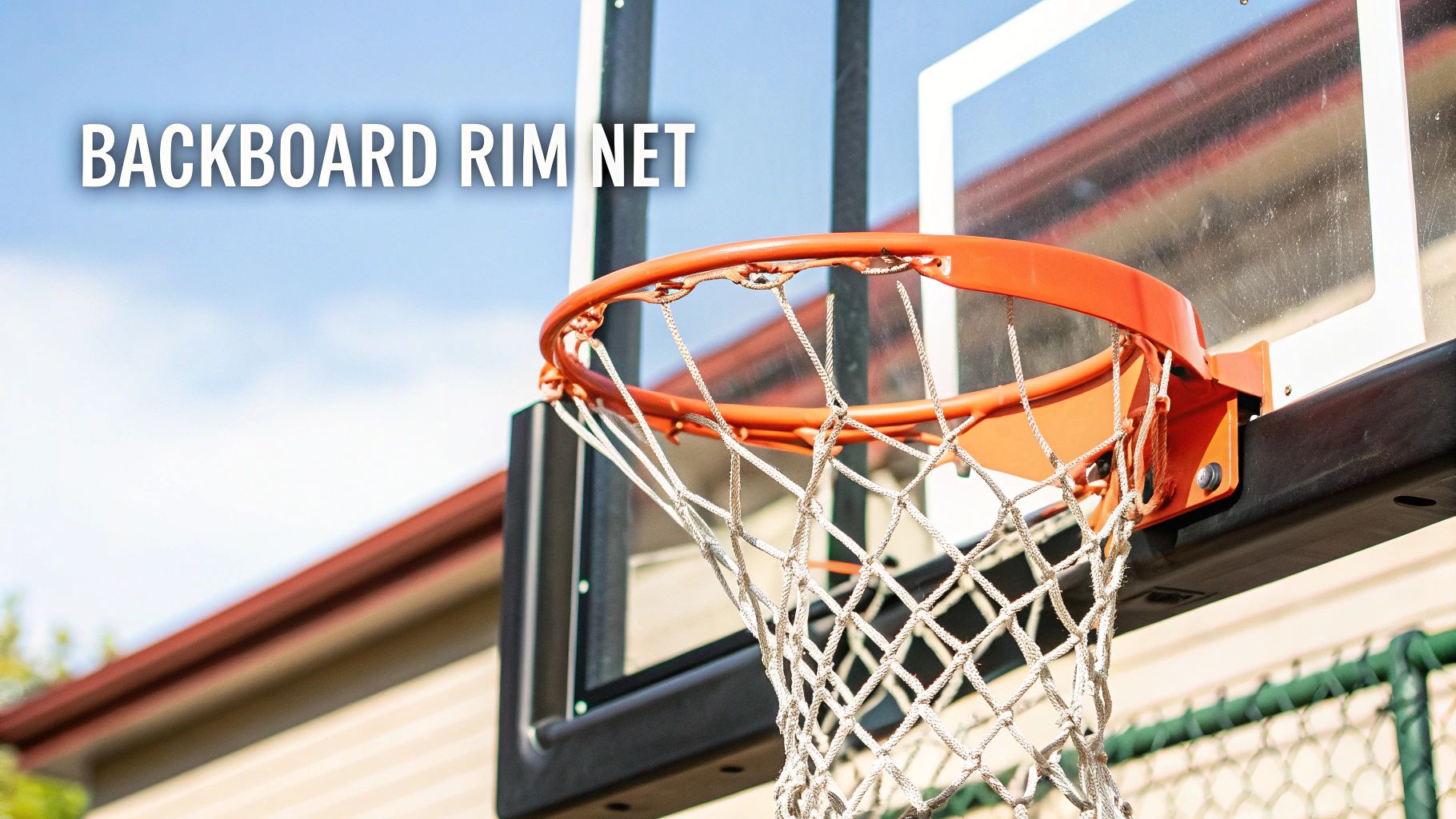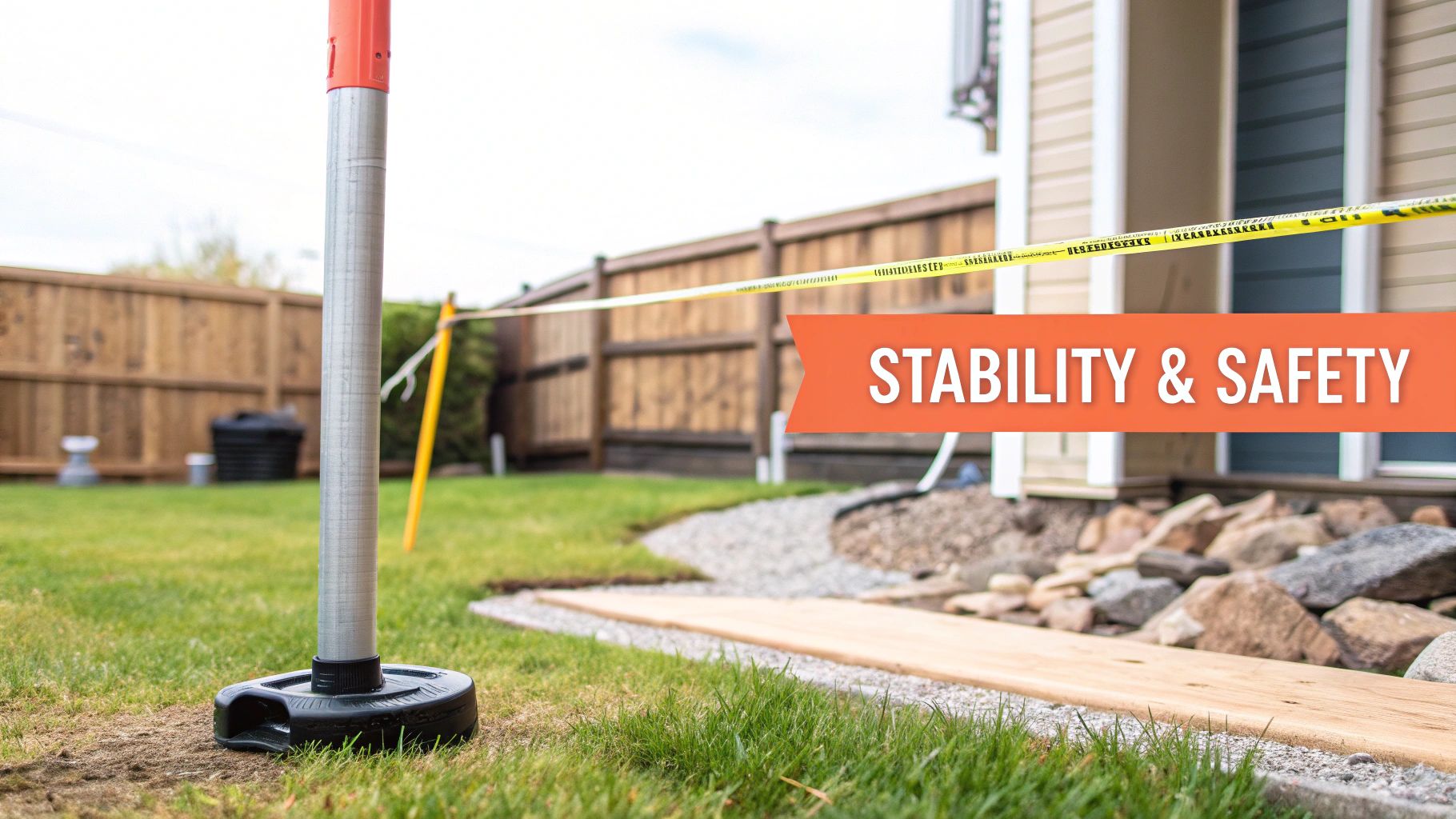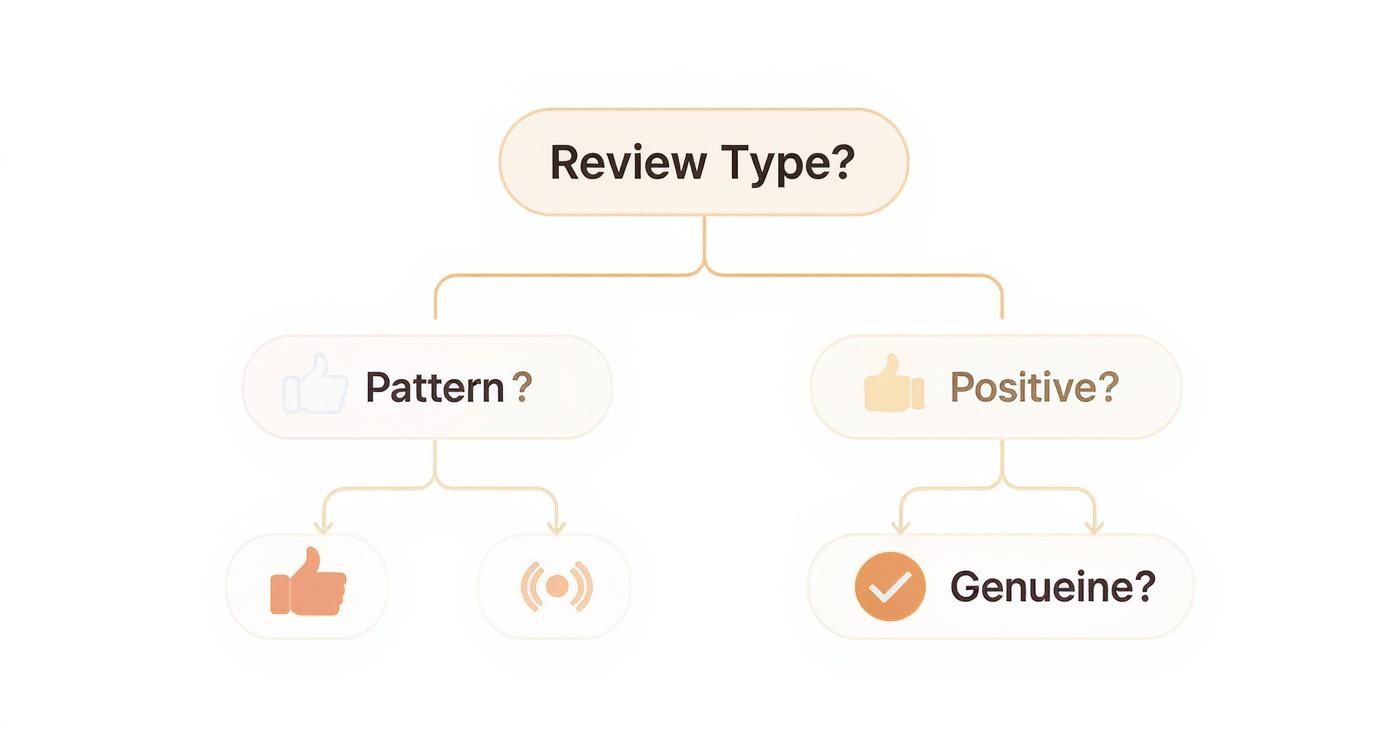-
CALL US:
- (866) 952-3456
Trying to sort through dozens of basketball hoop reviews can feel like a full-time job. But what you're really looking for is pretty simple: a hoop that’s built to last, stays put when you’re playing, and fits your driveway and your wallet. The best reviews are the ones that skip the sales pitch and get right down to what it's like to actually own and use the hoop day in and day out.
Picking out a basketball hoop is a real investment. You're not just buying a piece of equipment; you're buying years of pickup games, practice sessions, and family fun. And with the market expected to hit USD 1.14 billion by 2034, the sheer number of choices out there is enough to make your head spin. This guide will give you a simple framework to cut through the noise and figure out what other players are really saying.
The trick is to look past the simple star rating and search for patterns. One person having a bad day might leave a one-star review, and you can probably ignore that. But if you see five, ten, or twenty different people all complaining about a wobbly backboard or a height-adjustment crank that's impossible to turn, you've just found a huge red flag.
Instead of getting bogged down in every little feature, just zoom in on the three things that truly matter for any good hoop:
Think of yourself as a scout watching game film. You’re not just looking at the highlight reel (the five-star reviews). You’re watching for consistent, solid performance and spotting the little weaknesses that pop up when the pressure’s on.
Getting good at this means knowing how to read between the lines, no matter what website you're on. It can even help to see how other sports retailers present their customer reviews on sporting goods to get a feel for different layouts. The goal is always the same: find the real story about how a product holds up in the real world.

The first big decision you'll face when shopping for a basketball goal is picking the right system type. You can think of it as a classic player matchup: the powerhouse, dominant center against the speedy, versatile guard. Each one brings a totally different game to your home court, and the best choice really boils down to your space, budget, and how long you plan to stay put.
In-ground hoops are the dominant centers of the basketball world. They’re anchored directly into the ground with concrete, giving them unmatched stability and a pro-level playing experience. The pole isn’t going to wobble, and you’ll get that pure, consistent rebound off the backboard that feels just like an indoor gym.
Of course, that rock-solid performance comes with a serious commitment. Installation is permanent and involves digging a pretty big hole and pouring concrete. This makes them a perfect fit for homeowners who have a dedicated court space and aren't planning on moving anytime soon.
For serious players who want real performance, in-ground systems are the way to go. Their main benefits are clear:
The biggest hurdle with an in-ground hoop is the installation. It’s a permanent choice that takes some real planning and work, but the payoff is a hoop that feels like it belongs in a professional arena.
On the other side of the court, you have portable hoops—the versatile guards of the driveway. Their defining feature is, you guessed it, flexibility. You can roll them out for a pickup game and then tuck them away in the garage when you need the space back or during the off-season. This makes them a fantastic option for renters or families who aren't quite ready for a permanent fixture.
Their stability comes from a base that you fill with either water or sand, with sand being the heavier and more stable choice. While they can't quite match the rigid feel of an in-ground system, modern designs have come a long way. Still, even the best portable models will have some movement during heavy play.
If you’re on the fence but leaning towards a permanent setup, it's worth learning how to install an inground basketball goal to get a clear picture of what's involved.
To make the decision a little easier, let's break down the key differences side-by-side. Think about what matters most for your home court.
| Feature | In-Ground Hoops | Portable Hoops |
|---|---|---|
| Stability | Excellent. Anchored in concrete for maximum rigidity. | Good. Base filled with sand or water; some wobble is expected. |
| Performance | Professional, gym-like backboard response and feel. | Good for casual play, but less consistent rebound. |
| Installation | Permanent. Requires digging and pouring concrete. | Easy. Simple assembly and base filling. |
| Portability | None. Fixed in one location. | Excellent. Can be moved and stored as needed. |
| Durability | Built to last for many years with heavy-duty materials. | Good, but plastic bases can crack over time with exposure. |
| Best For | Homeowners, dedicated court spaces, serious players. | Renters, multi-use driveways, families with young kids. |
Ultimately, choosing between them is a trade-off. You're weighing the pro-level performance and permanence of an in-ground hoop against the flexibility and convenience of a portable one.

While the support pole is all about stability, your actual playing experience comes down to three things: the backboard, the rim, and the net. When you're scanning basketball hoop reviews, these are the components that directly control how the ball bounces, how a shot feels, and how long the whole setup will last.
Think of them as the engine, tires, and steering wheel of your hoop. Each one has a critical job to do.
A great backboard gives you that crisp, predictable bounce you need to dial in your bank shots. On the flip side, a cheap, flimsy one will just absorb the ball's impact, leading to dead rebounds and a whole lot of frustration.
The single most important decision for game-feel is the backboard material. You'll run into three main options, and each one plays very differently.
A quality backboard should feel like a solid wall, not a trampoline. When reviews mention a "true rebound" or "gym-like feel," they are often praising a high-quality tempered glass or acrylic backboard.
The rim and net are more than just the target; they complete the system. If there's any chance someone will be dunking on your hoop, a breakaway rim is an absolute must. These rims are built with springs that let them flex downward under heavy force, which saves both the player and the backboard from getting wrecked.
Standard, rigid rims are perfectly fine for shooting drills, but they can easily lead to a shattered backboard if someone tries to hang on them.
The net is a small detail that makes a huge difference. An all-weather nylon net will hold up against sun and rain, ensuring you get that satisfying swish for years to come. It's a tiny upgrade that pays off big time.
Getting these components right is key. Once you've made your choice, our guide on how to assemble a basketball hoop can walk you through getting it set up and ready for game day.

A shaky basketball hoop is more than just an annoyance that throws off your shot—it's a massive safety hazard. When you're digging through basketball hoop reviews, stability should be the one thing you absolutely refuse to compromise on. It’s the foundation for both solid performance and your peace of mind.
For in-ground systems, real stability boils down to two things: the anchor system and the thickness of the support pole. Think of the anchor like the roots of a giant oak tree. A deep, concrete-secured anchor ensures the whole structure stays put, even when someone is hanging off the rim. A thicker steel pole is your defense against the sway and vibration that can completely ruin a game.
With portable hoops, it's all about what’s holding it down: the base. You'll typically have to choose between filling it with sand or water, and believe me, it’s not an even match.
Sand is the clear winner for maximum stability. It's much denser than water, which makes the base a whole lot heavier and far less likely to tip over during a hard layup or dunk. Sure, water is easier to fill, but it can freeze and crack the base if you live in a colder climate.
The size of the base matters, too. Look for one that holds 35 gallons or more, which provides a solid enough foundation for most backyard family fun.
Beyond the base, there are a couple of other safety features you can’t overlook:
At the end of the day, a stable and safe setup is everything. For anyone leaning towards an in-ground system, getting familiar with the professional installation of a basketball hoop can really open your eyes to what it takes to achieve that rock-solid security you're looking for.
Online basketball hoop reviews are a goldmine of real-world info, but only if you know how to dig for it. A simple star rating doesn't come close to telling the whole story. To get the real scoop, you need to think like an analyst, filtering out the noise to find the nuggets of truth that actually matter.
It's easy to get swayed by one person's heated complaint or another's five-star rave, but the real insights come from spotting recurring themes. Think of it like a scouting report—one bad game is just an outlier, but a consistent weakness week after week is a genuine problem. When multiple buyers bring up the same broken part, a maddening assembly step, or terrible customer service, you've just uncovered a real product flaw.
When you're scrolling through reviews, zero in on comments that talk about the three most common pain points. These are the areas that reveal way more about a hoop's true quality than any glossy marketing brochure ever will.
A single bad experience weighed against a flood of positive feedback isn't a dealbreaker. But the collective wisdom of hundreds of buyers? That's your best tool for dodging a bad purchase.
This kind of buyer feedback has a massive impact on the market. The rise of online reviews has given customers a powerful voice, pushing manufacturers to step up their game to keep their ratings high. You can learn more about this trend and discover insights into the basketball hoop market on futuredatastats.com.
Making the final call on a basketball hoop is about more than just picking a brand. It’s where you bring everything together—from stability and safety to the backboard material. Before pulling the trigger, it’s smart to run through one last huddle to make sure your choice is a perfect fit for your family and your home. This final check ensures you're investing in a hoop that will deliver years of fun.
First things first, confirm the hoop type actually works for your space. Is digging for an in-ground model a real possibility, or do you need the flexibility of a portable system you can move around?
Next, give the backboard material a second look. For most driveways, an acrylic backboard hits that sweet spot, offering a great balance of pro-style performance and durability. You also want to verify the key safety features. Look for good pole padding and a safe offset—the distance between the pole and the backboard—to keep players from crashing into the support during layups.
Finally, think about the complete investment. Don't forget to look into the cost to install a basketball hoop, because getting it professionally assembled is often a smart move for safety and your own peace of mind.
This simple decision tree shows you how to sort through reviews to tell what’s genuine feedback and what might just be an isolated complaint.

The real takeaway here is to look for patterns. One-off bad reviews happen, but when you see the same issue popping up over and over, that’s when you’ve likely found a true flaw in the product.
Diving into the world of basketball hoops can definitely bring up a few questions. We see the same ones pop up in basketball hoop reviews all the time, so let's tackle them head-on and get you the clear answers you need to make a great choice.
For most driveways, acrylic really hits the sweet spot. It gives you that glass-like rebound performance and solid durability without the hefty price tag of real glass. Polycarbonate is another fantastic option, since it's practically indestructible and perfect for withstanding years of intense family games.
And what about putting it all together? You should plan on a portable hoop taking about 2-4 hours to assemble, and you'll definitely want a second person to help. The trickiest parts are usually lifting and attaching the heavy backboard and then, of course, filling the base.
The official NBA and NCAA regulation height is 10 feet from the court surface to the top of the rim. Just about every adjustable hoop you can buy for your home will reach this height, but they also lower—often down to around 7.5 feet—which is great for younger kids just starting out.
When it comes to filling the base of a portable hoop, sand is always the better choice. It's much denser than water, which makes the whole system significantly heavier and more stable. Plus, you don't have to worry about water freezing and cracking the base in colder climates.
Going with sand is just a smart move for long-term safety and stability. And while you're creating the perfect home court, think about adding other gear to step up your game. An agility ladder, for example, is a great tool for improving your footwork and quickness.
Ready for a professional, stress-free setup? Let Assembly Smart handle the heavy lifting and confusing instructions. Get your new hoop assembled correctly and safely by our experts. Get Your Free Quote Today!